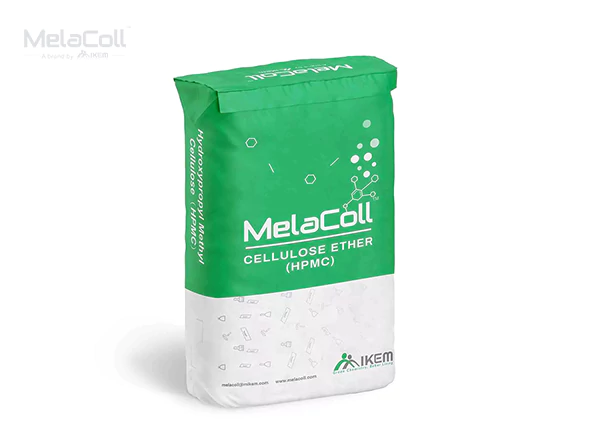
In modern building decoration, wall putty is a fundamental material for wall preparation, and its quality directly affects the overall appearance and durability of the finish. To enhance the application performance and final quality of wall putty, hydroxypropyl methyl cellulose (HPMC) has become a commonly used additive. However, using HPMC involves several key factors that are critical to the putty's performance and effectiveness. For builders and materials developers, understanding the following five key questions is essential. The answers to these questions will help optimize the formulation and application of putty, ensuring the quality and longevity of wall finishes, and ultimately leading to a better construction experience and outcome. Let’s see how well you know about these questions.
1. What is the role of HPMC in wall putty?

Melacoll® HPMC can ignificantly enhances the water retention of the putty.
Answer: HPMC plays a vital role in wall putty. Firstly, it significantly enhances the water retention of the putty and ensures that water is not easily lost during the drying process, thus avoiding premature drying or chalking of the putty. Secondly, HPMC has a thickening effect that adjusts the viscosity of the putty to make it easier to work with and improves the thixotropy of the putty to ensure smoothness and uniformity during application. HPMC also improves the workability of the putty, making it smoother to scrape, prolonging the workable time, and helping to form a smooth and even wall surface. In addition, it enhances the adhesion of the putty to the substrate, ensuring that the putty layer is firmly adhered to the wall surface, reducing the risk of peeling and cavitation. Finally, HPMC improves the anti-sagging properties of putty, especially when working on vertical walls, effectively preventing the putty from sagging and ensuring a uniform coating thickness. These combined effects make HPMC an indispensable and important additive in wall putty, significantly improving the quality and durability of wall decorations.
2. What is the effect of the amount of HPMC added on the performance of putty?
Answer: The additive amount of HPMC has a significant effect on the performance of putty. Adding HPMC in the right amount can optimize the water retention, thickening, and adhesion of the putty, and improve the smoothness of construction and the anti-sagging properties of the putty. However, adding too little HPMC may not give full play to these advantages, resulting in the putty drying too fast, insufficient adhesion, or reduced workability; while adding too much HPMC may result in the putty having too high viscosity, which makes it difficult to spread during construction and may affect the hardening speed and surface smoothness of the putty. Therefore, precise control of the amount of HPMC added is the key to ensuring that the putty achieves the best performance and improves the construction quality and wall effect.
3. How does HPMC perform under different climatic conditions?

HPMC's excellent water retention can effectively slow down the evaporation of water from the putty, preventing it from drying out and cracking prematurely, thus ensuring the quality of the wall surface.
Answer: HPMC shows stable and reliable performance under different climatic conditions. In dry climates, HPMC's excellent water retention can effectively slow down the evaporation of water from the putty, preventing it from drying out and cracking prematurely, thus ensuring the quality of the wall surface. In humid climates, HPMC's moisture resistance helps to control the moisture absorption of the putty, thus preventing blistering, deformation, or peeling of the wall surface. In high-temperature conditions, HPMC's thermal stability keeps the putty working for the proper amount of time during construction, preventing it from hardening too quickly. In a low-temperature environment, HPMC can also maintain the fluidity and workability of putty, preventing putty from becoming too thick or difficult to apply due to low temperature. Therefore, HPMC can ensure the stability and workability of putty under changing climate conditions, and adapt to the wall decoration needs of different regions and seasons.
4. How does HPMC interact with other putty additives such as gypsum or latex powder?
Answer: HPMC has a synergistic effect with other putty additives such as gypsum and latex powder to optimize the overall performance of the putty. When combined with gypsum, HPMC's water retention and thickening action improves the workability of gypsum putty, extends the operating time, prevents drying out and cracking, and improves putty adhesion and surface flatness. Latex powder provides excellent adhesion and anti-cracking properties and complements the thickening and water retention function of HPMC to form a more resilient and durable putty layer. HPMC can also effectively regulate the viscosity and thixotropy of the putty so that the putty mixed with latex powder is easier to apply and has better leveling properties. Through reasonable proportioning, HPMC, gypsum, and latex powder can enhance each other, and improve the putty's anti-cracking, water resistance, and construction performance, ensuring that the wall surface is smooth, beautiful, and durable.
5. What is the optimum viscosity of HPMC in putty?
Answer: The appropriate viscosity of HPMC in putty usually depends on the specific formulation of the putty, the application environment, and the construction requirements. In general, HPMC viscosities suitable for wall putty range from 40,000 to 100,000 mPa.s (based on viscosity measurements of a 2% aqueous solution).
Impact of Viscosity Selection
Low viscosity HPMC (40,000 - 60,000 mPa.s): for putties that require higher flow and lower consistency for fast application and spreading. These viscosities are suitable for thin coats or for use in warm environments as they dry faster and are easier to work on in large areas.
Medium Viscosity HPMC (60,000-80,000 mPa.s): balances flow and water retention and is suitable for most general-purpose applications of exterior putty. This type of viscosity provides good workability and prevents the putty from cracking or flaking during drying.
High Viscosity HPMC (80,000-100,000 mPa.s): For putties requiring higher water retention and longer open time, it is suitable for use in hot, dry environments or where thicker coats are required. This viscosity helps putty to maintain proper moisture and adhesion during a long working time and prevents putty from drying out prematurely.

Melacoll®HPMC Viscosity
How to determine the right viscosity
Testing and adjustment: According to the specific application requirements, it is recommended to test HPMC with different viscosities through small batch trials and observe the water retention, fluidity, workability, and final drying effect of the putty, so as to determine the most suitable viscosity range.
Construction environment
You also need to consider the ambient temperature and humidity of the construction. If it is in a hot and dry environment, it may be more appropriate to choose a high viscosity HPMC; if it is in a cold and humid environment, it may be possible to choose a low or medium viscosity HPMC.
Conclusion
The application of HPMC as a key additive to putty involves several critical issues. By exploring the role of HPMC in putty, the effect of the amount added, its performance under different climatic conditions, its interaction with other additives, and the optimum viscosity selection, we can gain an in-depth understanding of how to optimize the formulation and application of putty. This not only helps to improve the quality and durability of wall finishes but also leads to a better construction experience and results for building projects. In conclusion, a precise understanding of the use of HPMC ensures that the desired wallcovering results are achieved under all conditions. If you still have any questions or business need for HPMC in wall putty, welcome to contact us at any time.


Leave a Reply